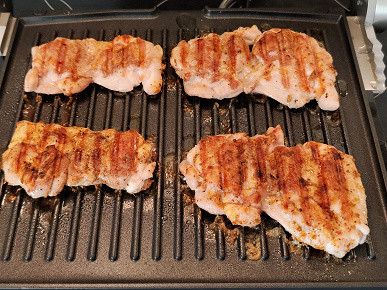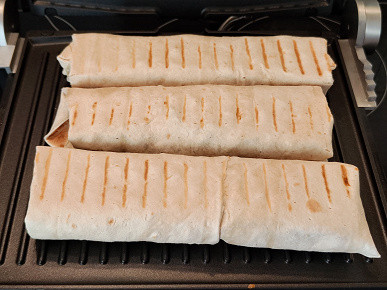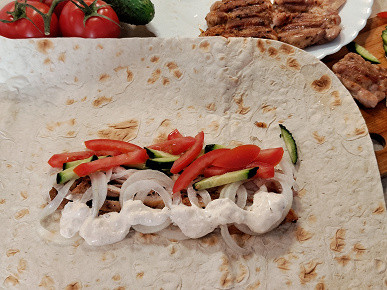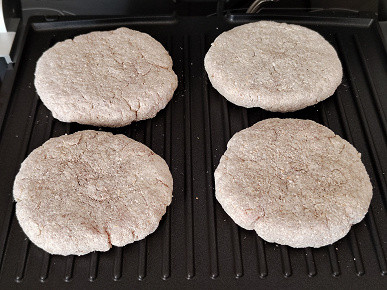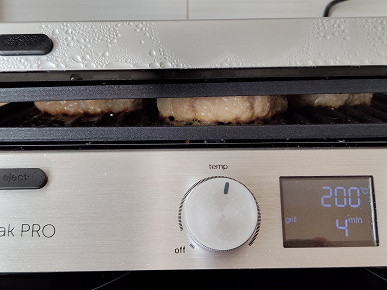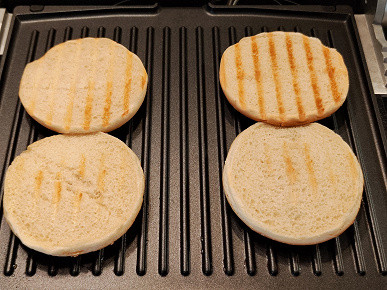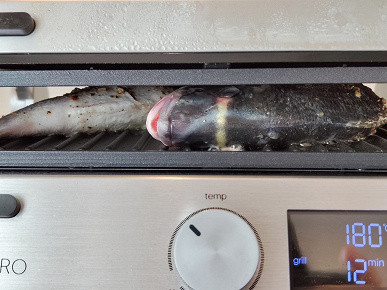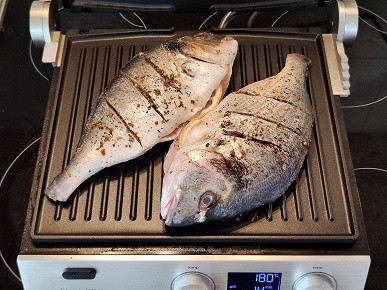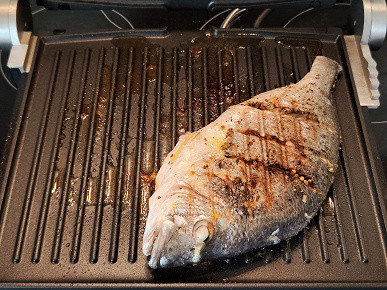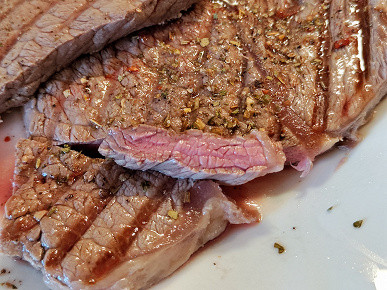Today we tested the Polaris PGP 3005 — a contact grill that incorporates all the advantages and advantages of this type of kitchen appliance. The device has high power, allowing you to quickly prepare your favorite grilled products and maintain the temperature of the panels up to 240°C. The non-stick coating prevents delicious browned crusts from sticking, and the removable panels are easily dishwasher safe, eliminating the hassle of cleanup. The grill also offers BBQ and mini-oven modes and comes with a baking dish. This device is a real dream for a cook!
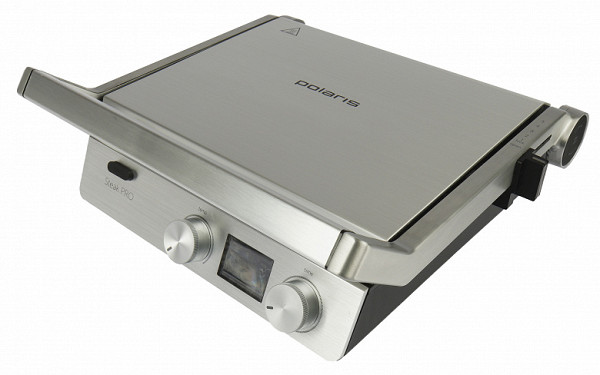
During the experiments, we will find out whether all the declared advantages are real and how pleasant and convenient it is to work with the Polaris PGP 3005 press grill.
Characteristics
| Manufacturer | Polaris |
|---|---|
| Model | PGP 3005 |
| Type | Electric Contact Grill |
| Country of Origin | China |
| Guarantee | 3 years |
| Warranty period for panel coating | 6 months |
| Life time * | 3 years |
| Declared power | 2000 W |
| Body material | stainless steel |
| Plate material | metal with non-stick coating |
| Capture Zone Material | metal |
| Control | electronic |
| Indicators | sounds: ready for work, finished work |
| Smooth temperature control | yes, from 160°C to 240°C in 10°C increments |
| Timer | up to 30 minutes in 1 minute increments |
| Accessories | grease collection container, baking dish, scraper |
| Peculiarities | removable plates with built-in heating element, adjustable top panel height, four modes of operation: contact grill, barbecue, mini oven and oven |
| Length of power cord | 85 cm |
| Dimensions (W×H×D) | 37×17×36 cm |
| Plate size | 29×25.5 cm |
| Weight | 5.2 kg |
* Contrary to popular belief, this is not a period after which the device will necessarily break down. However, after this period, the manufacturer ceases to bear any responsibility for its functionality and has the right to refuse to repair it, even for a fee.
Equipment
The device is supplied for sale (or to us for testing) in a cardboard box, decorated in a stylish and sophisticated design from Polaris. On a dark background there is a photograph of the device indicating its name and main characteristics. Detailed information about the capabilities and features of the Polaris PGP 3005 grill is provided on the sides of the packaging, which allows you to get a complete picture of the device. There is a plastic handle on the top of the box for easy carrying.

Inside the box, the device is held motionless thanks to foam inserts. A sheet of foam placed inside the grill prevents scratches on the non-stick coating of the panels during transport and storage. After opening the box we found the following components:
- ready-to-use grill body with a removable tray for collecting oil/fat;
- baking dish;
- a spatula for cleaning panels;
- user manual, recipe book, warranty card and advertising brochures.
At first sight
Straight out of the box, there were two stickers on the lid of the grill: with brief instructions and with key advantages of the device. Everything is removed easily and without a trace.
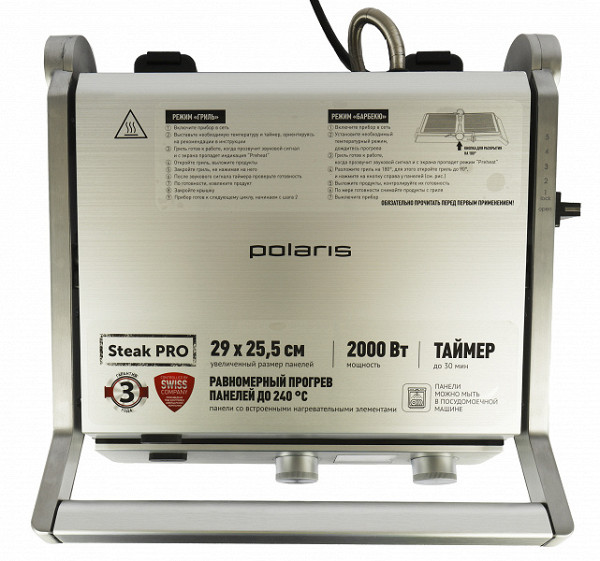
The body of the Polaris PGP 3005 pressure grill is made of matte silver metal with a light shade over almost the entire surface. The lower side parts of the case and individual controls are made of black plastic. The design of the device is very neat, stylish and solid — without unnecessary details. The case materials are pleasant to the touch.

The control panel of the Polaris PGP 3005 grill is represented by a display and round rotary controls for setting the temperature and cooking time. It is located on the front side of the lower part of the case, which makes it convenient and accessible for use.
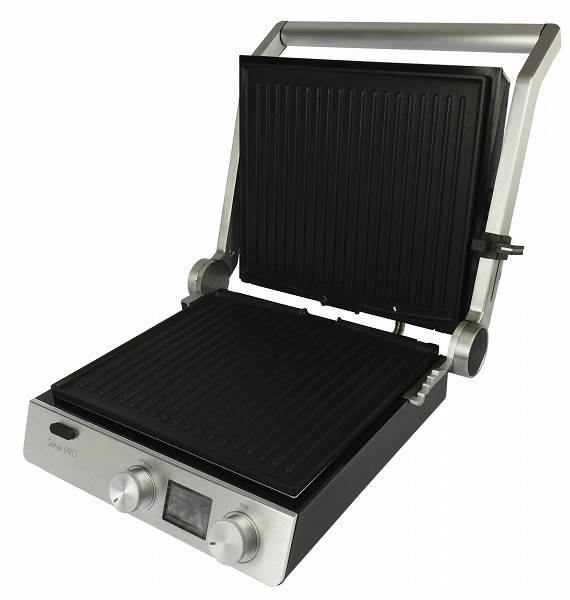
The grill lid is opened using a massive metal handle curved upward.
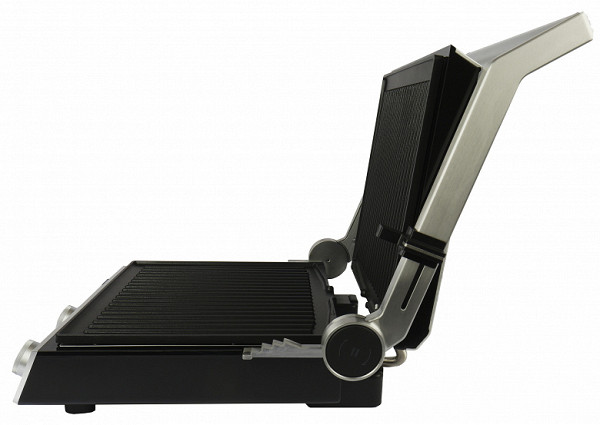
Using the lock, you can choose one of five options for the distance between the panels. In the «Open» mode, the lid opens up to 90° and, when closed, is pressed tightly against the bottom panel, providing additional pressure from above on the food being prepared.
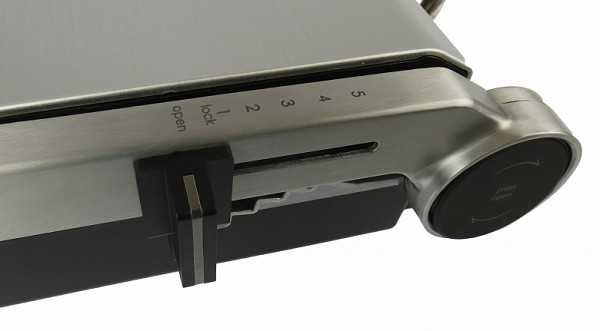
By pressing the large button on the right, you can open the panels in barbecue mode by 180°. When fully unfolded, the handle serves as a support for the top panel.
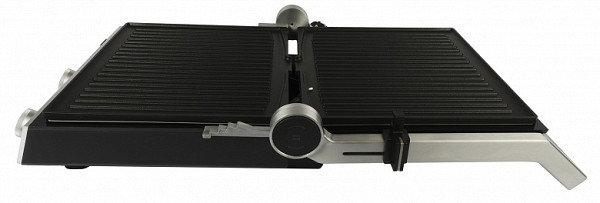
Corrugated working panels with a built-in heating element are made of metal with a non-stick coating. The coating appears durable and evenly applied. The top and bottom panels are identical and can be used on both the lid and the grill body. The panels are secured with a clamp and are removed by pressing the black buttons with the inscription «Eject» protruding from the body. The panel size is 29x25.5 cm.

After removing the panels, on the inside of the cover and base we see a contact group and a temperature sensor in the center.
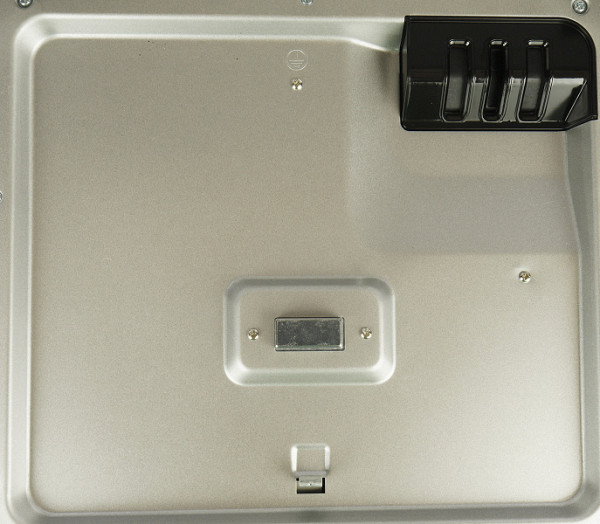
At the bottom of the grill there are ventilation holes, four legs with anti-slip pads, a compartment for winding a cord and a sticker with technical information.

On the left side there is a removable fat tray that extends diagonally.

Next to the tray, a cable is attached to the body that connects the top and bottom panels. The 85 cm long power cord comes out from the side of one of the legs.

The grill is equipped with a plastic scraper for cleaning the panels...

...and a square metal baking pan with a non-stick coating. The width of the mold is 22 cm, the height is 5 cm.
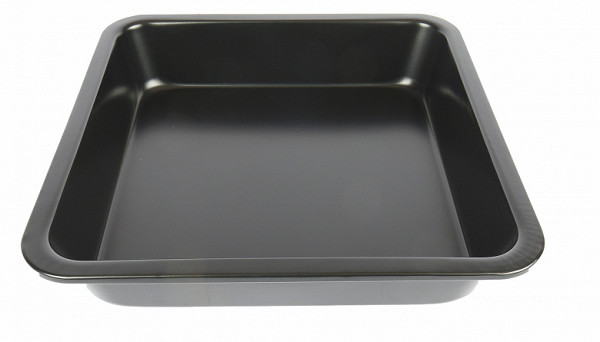
The appearance of the Polaris PGP 3005 grill press left us with an extremely positive impression. All elements of the case fit together precisely, the materials look high quality, and we did not notice any visible flaws.
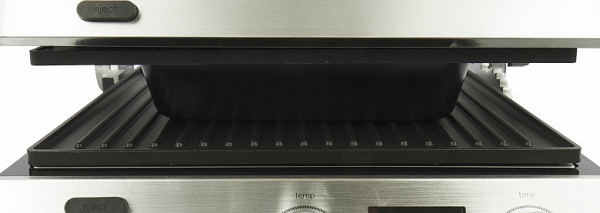
Instructions
The instruction manual is presented in the form of a color brochure, printed on thick glossy paper and designed in the company's corporate style.
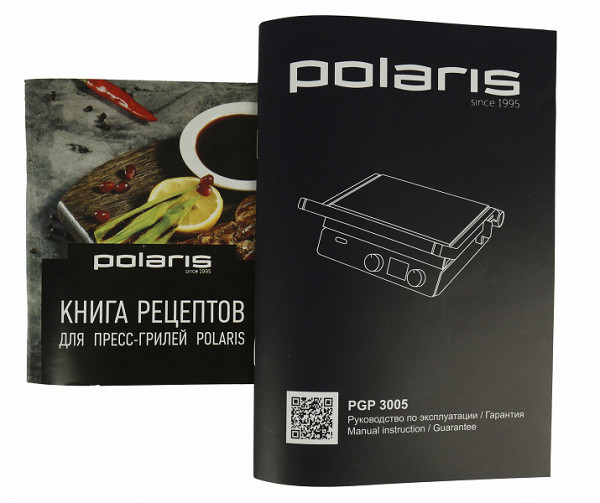
The book contains detailed instructions for use, general information about the device, operating instructions, and also provides recommendations for caring for it. In addition to the instructions, the kit includes a warranty card and an illustrated recipe book.
Management
Operating the grill is very simple. Let us remind you that there are only two regulators: time and temperature. Between them is a display.
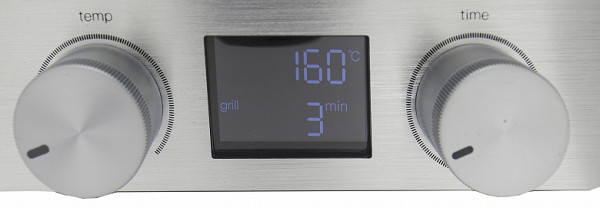
There are no markings on the body around the controls, except for “off” by the left knob. With each rotation, the value of the adjustable parameter on the screen changes.
The left rotary control has 9 positions with a clock stroke. The temperature setting range is from 160 to 240 °C in 10 °C steps. The right knob is designed to set the cooking time from 1 to 30 minutes in 1 minute increments. The regulator moves freely.
After connecting to the network, a short beep is heard, and you can begin setting up operating parameters. After selecting the temperature and time, if you do not make additional turns of the knobs, heating begins after a few seconds, which is displayed on the screen by the flashing word “preheat”.

When the set temperature is reached, the beep will sound again and the screen will display the set temperature, a countdown and the word «grill» instead of «preheat».
When heated to 230 or 240 °C, “sear” will first appear on the screen. This mode is designed for quickly searing, for example, steaks, to “seal” the meat and retain its juices.

At the end of the set time, a dotted line will appear on the screen and heating will stop. After this, you must manually turn the temperature regulator to the “off” position.
If the timer was not initially set, the screen will only show the current temperature and a dotted line instead of a countdown. In this case, the heating is also turned off independently by turning the temperature regulator to the “off” position.
Exploitation
At the beginning of operation, we installed the Polaris PGP 3005 grill press on a flat, dry table surface, and carefully wiped the body with a damp and then dry cloth. After this, the panels were removed and washed with a neutral detergent. The dried panels were placed back into the body and, according to the instructions, they were calcined at maximum temperature for 10 minutes. There was a slight technical smell that quickly disappeared. After the panels had cooled, we removed them again and washed them under running water with the same mild detergent.
The Polaris PGP 3005 grill press offers three options for use:
- Like a contact grill with a pressure lid.
- Like a barbecue roaster with frying panels opened 180°.
- Like a mini-oven, where the top panel either does not touch the product or slightly presses it.
- As an oven for baking dishes in foil forms or a complete baking sheet.
During testing, we did not encounter any difficulties in working with the grill press. Food cooked evenly and quickly without burning, even without the use of oil. The controls are simple and logical, suitable for any user, and the ability to adjust cooking parameters during the process is very convenient.
The thermal insulation of the case is excellent: the outer surface of the lid, sides and bottom of the device hardly heat up, which eliminates the possibility of getting burned. The handle remains cold during operation.
The only thing to note is the size of the grease tray and its placement. The tray successfully collects excess liquid during the frying process, however, when opening the lid, drops of condensation or fat sometimes flow not only into the central tray, but also across the entire width of the panel, ending up on the table. This minor inconvenience requires regular wiping of the table surface after use.
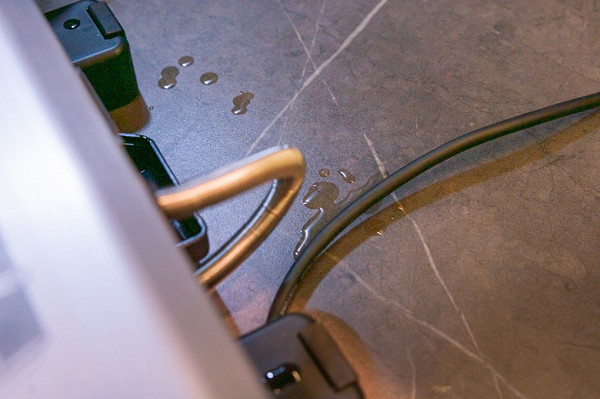
Also, when frying moist, juicy foods, condensation accumulated on the front side of the grill top.
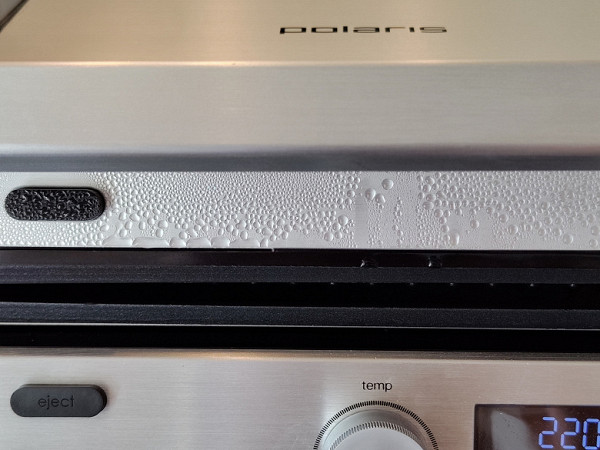
In general, condensation on the external parts of the grill did not affect the quality of the grill. The heating power turned out to be sufficient for preparing various juicy products. The Polaris PGP 3005 grill press successfully passed all our tests. There are minor comments regarding the uniformity of heat treatment: pieces placed closer to the edge sometimes turned out to be slightly paler than the central ones. However, all the ingredients were perfectly cooked and fried. The slight unevenness of browning even proved beneficial—some of our testers preferred a more golden crust, while others preferred the meat less well done.
Care
Taking care of the grill is not difficult at all, the main thing is to clean the panels immediately after use. The nice thing is that they are dishwasher safe. You can also gently place a damp towel or wipes on the hot panels without touching them and close the lid. After a few minutes, open the grill, remove the napkin and wipe the surface of the panels with a dry soft cloth or paper napkin. It is convenient to use the special scraper that comes with the kit — this is shown in the photo below.
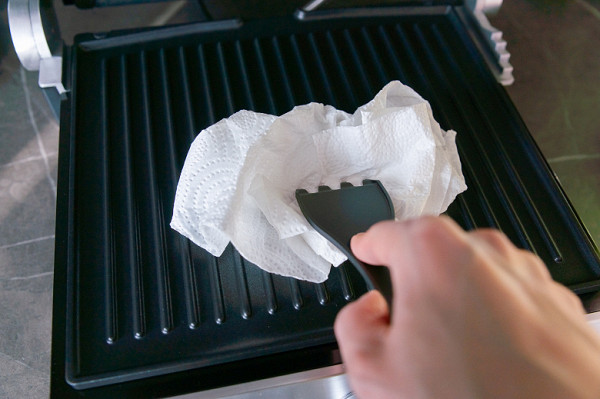
If it happens that after cooking you leave the dirty panels to cool and start tasting, you can safely wash them with water with the soft side of a sponge and use a neutral detergent. The main thing is to avoid harsh chemicals and sponges with harsh, scratchy surfaces.
Our measurements
The grill power during heating ranged from 1860 to 1930 W. To illustrate energy consumption, here are a few examples:
- When frying nine cutlets in two batches, the device consumed 0.347 kWh.
- 0.308 kWh was consumed for the cycle of frying chicken thigh fillets and preparing shawarma.
- In barbecue mode, the device operated at 240°C for about 8 minutes, consumption was 0.205 kWh.
- 4To bake a cottage cheese cake for 30 minutes at 180 °C, 0.217 kWh was consumed.
We also took temperature measurements at various points of the device. It was confirmed that the surface of the grill lid practically does not heat up during operation: the temperature in different places ranged from 25 to 30 °C. The front of the top panel got a little hotter, reaching 36 °C, but this also does not pose a danger to the user. The handle and sides of the case remained cool.
| Set temperature, °C | Heating time, min:sec | Top panel | The bottom panel | ||
|---|---|---|---|---|---|
| Lowest temperature | The highest temperature | Lowest temperature | The highest temperature | ||
| 160 | 2:03 | 112 | 166 | 119 | 178 |
| 200 | 2:38 | 171 | 211 | 180 | 234 |
| 240 | 3:29 | 211 | >260 | 234 | >260 |
The device heats up quite quickly when closed. The maximum temperature could not be measured because the infrared thermometer showed the letter “H” on the display, indicating a temperature above 260 °C on the test surface. The lowest temperature was recorded in the depth of the grill on the left, which confirms the results of our tests.
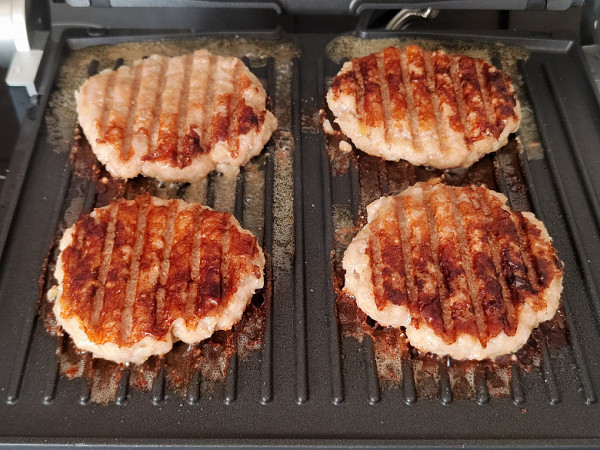
Practice tests
Shaverma
Four chicken thigh fillets were marinated in a mixture of salt, spices and vegetable oil.
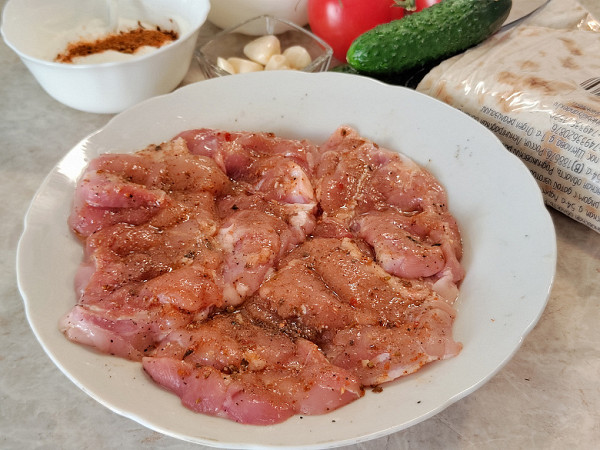
The following operating parameters were set: temperature – 200 °C, duration – 4 minutes. After the sound signal indicating the end of heating, the fillet was placed on a hot panel.
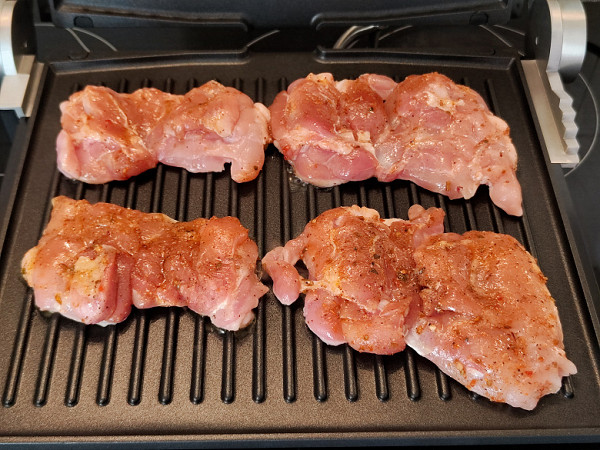
We used the contact grill mode, pressing the lid onto the food. During the frying process, a significant amount of moisture was released: some of it flowed into a special container, and the other part evaporated from the surfaces of the panels. Condensation was deposited on the outside of the front of the grill lid. After 4 minutes, we checked the condition of the fillets, decided to increase the temperature to 220 °C and added another 3 minutes for additional cooking. The photo on the right shows the reverse side of the fillet. As expected, the underside of the chicken was slightly less browned than the top as the juices and fat had drained here.
We cut all the ingredients into strips and mixed the sauce with sour cream, garlic and spices.

We rolled three shawarmas and browned them for a few minutes at 220 °C. Our goal was not to completely heat the contents, since the chicken was already warm, and the grill coped with frying the pita bread very quickly.
Crispy pita bread, spicy sauce and perfectly fried warm chicken — our homemade shawarma was a great success. Fast, clean and, let’s not be afraid of this word, healthy.
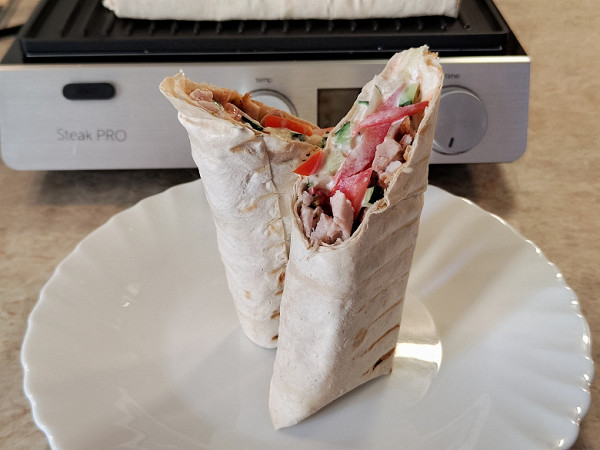
Contact grills are ideal for grilling various types of fillets. Poultry or meat cooks quickly, you can do without oil, and cleaning takes a minimum of time. Unlike frying in a pan, the Polaris PGP 3005 contact grill heats up efficiently and maintains an optimal temperature, which allows you to brown a piece of fillet well, despite the moisture released.
Result: excellent
BBQ shrimp and meat
300 g of shrimp were marinated in a mixture of soy sauce, vegetable oil, a mixture of peppers and garlic. The beef was kept for about 15 minutes (while the shrimp were being cooked) at room temperature.

We preheated the grill to a maximum of 240 °C. After the signal that the temperature had been reached, the panels were opened 180°. Shrimp were placed on one half and thin slices of beef on the other. It's nice to note that the surface of the table remained cool, since the outer sides of the grill practically did not heat up.
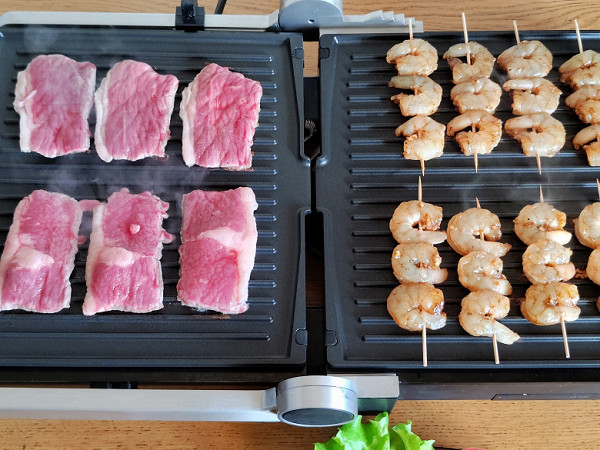
In five minutes both shrimp and meat were ready.
Fast, tasty and quite atmospheric — what an idea for a grill party? We would also like to mention that in this mode of operation you can fry different foods without mixing their smell and taste.

Result: excellent
Hamburger
The initial plan to simply fry the cutlets immediately changed. In the process of shaping and pressing them on the grill, it became obvious that the cutlets could not remain the main dish, since they also required buns inside, complemented by cheese and vegetables. I do not remove the breading, preferring to call the dish not a “burger”, but a “bun with cutlet”.
We prepared the next portion in the mini-oven mode, setting the top panel to level “1”. She touched the cutlets, but did not press them too hard. The temperature was first set to 200 °C and fried for 5 minutes, then reduced to 180 °C and the cutlets were cooked for another 2 minutes.
A lot of moisture was released, it flowed down, evaporated and did not at all interfere with the formation of a crust on the underside of the products.

We cut fresh tomatoes and pickled cucumbers into thin slices and prepared several lettuce leaves.

We then lightly browned the bun halves at 180 °C for three minutes at the first lid height. In pressure grill mode this would be impossible — the buns would simply be flattened. During testing, we noticed one feature: the lid does not fix horizontally; it puts more pressure on the halves of the buns located in the depths, closer to the far edge. Therefore, if you need to cook delicate foods that cannot be squeezed, you should set the gap between the panels higher and place the pieces closer to the outer edge of the grill.
While the buns and cutlets were warm, we began assembling. The bottom half was greased with cheese sauce, a lettuce leaf, a couple of tomato slices, a cutlet, a few slices of cucumber, cheese were placed on it, and the top half of the bun was greased with the same sauce.
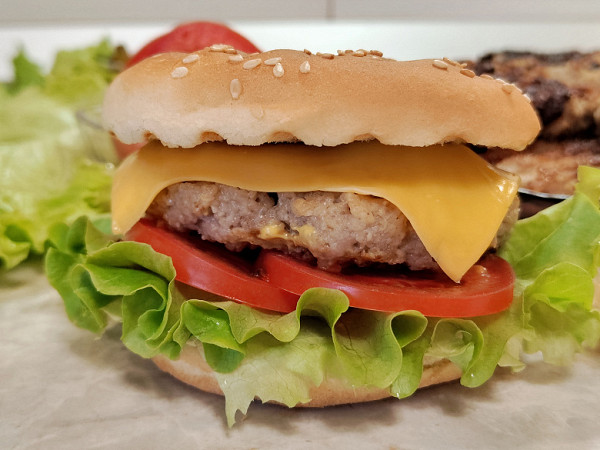
In this test, we used the grill in two modes — contact and as a mini-oven with the lid in a fixed position. The second option made it possible to cook cutlets that were not too thin and to toast the bun without crushing it.
Conclusion: the result is excellent!
The grill is great for cooking evenly chopped steaks and toasting toast or hamburger buns.
Curd cake
Ingredients for the dough: wheat flour — 200 g, egg — 88 g, cottage cheese — 150 g, butter — 54 g, sugar — 150 g, baking powder — 1 tsp, soda — ¼ tsp, a pinch of salt.
First, beat the butter and sugar until smooth. Gradually added the egg, continuing to beat. Then cottage cheese and sifted flour were added to the dough along with the rest of the dry ingredients. The resulting dough turned out to be thick. The baking dish was greased with oil, sprinkled with semolina and the dough was placed in it, leveling it with damp palms.
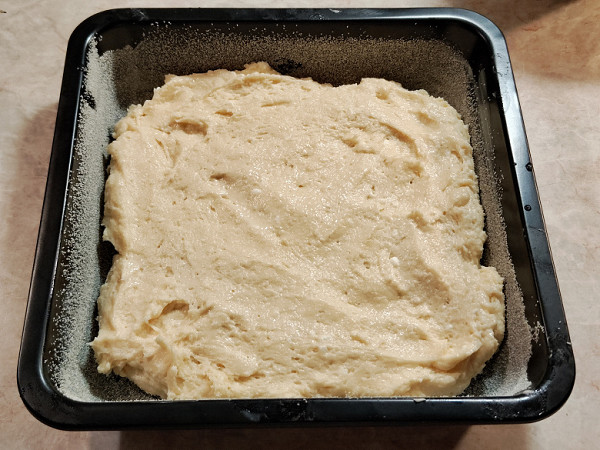
Bake for 30 minutes at 180 °C. The top grill panel lies on the pan; when baking, keep in mind that the dough will increase in size and may rise to the height of the frying surface.
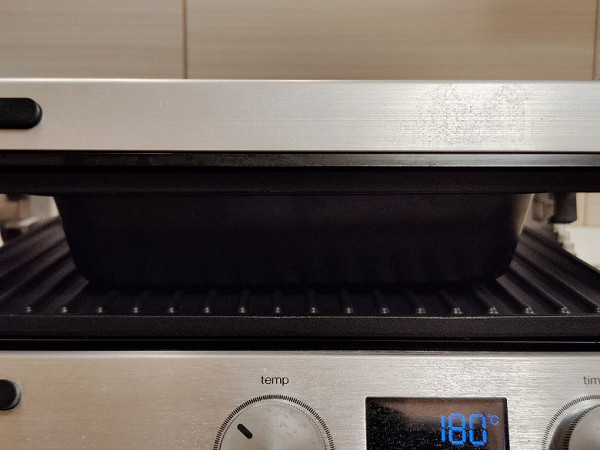
This is exactly what happened to us. However, the surface of the cake did not burn, but was only beautifully fried, and a nice ribbed pattern formed on the outside of the baked goods.
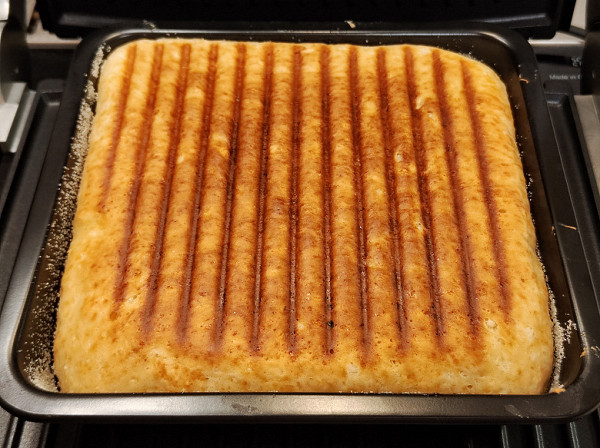
A fried crust formed on the top and bottom, the sides turned out lighter. The inside of the cake was baked, despite the moist texture. Having cooled down, it sank a little.

We conclude that you can use the oven together with a baking dish.
Result: excellent
Dorada
Until today, the author had never grilled a whole fish. Usually they cook salmon fillets or steaks, but then a sea bream swam by. The fish is not very thick at the spine, but fatty enough for good baking. From the idea to the fish being ready, only an hour passed, which the sea bream spent in the marinade.
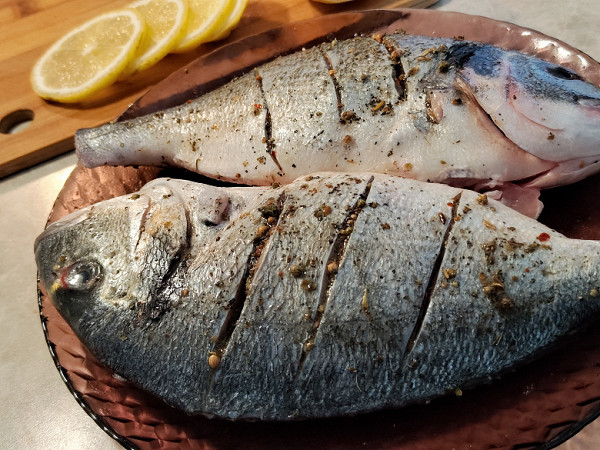
They put a slice of lemon in the belly, preheated the grill to 180°C and placed both fish on the grill at once. The sea bream is medium in size — the carcasses are 400-600 g.
We planned to fry for 15 minutes, but after five minutes we decided to increase the temperature to 190 °C. The fish was cooked for another 8 minutes. Then they inserted a thermometer deep into the pulp, were surprised at the result and immediately turned off the grill.
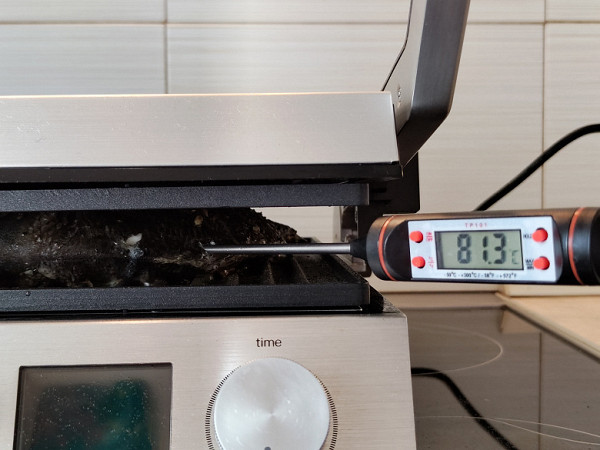
Note how easily the fish separated from the panel; not a piece came off or stuck to the frying surface.
In total, in 13 minutes the fish was perfectly cooked from the inside, the flesh easily came away from the ridge, the skin was covered with a baked crust — an excellent result. Very fast and clean.
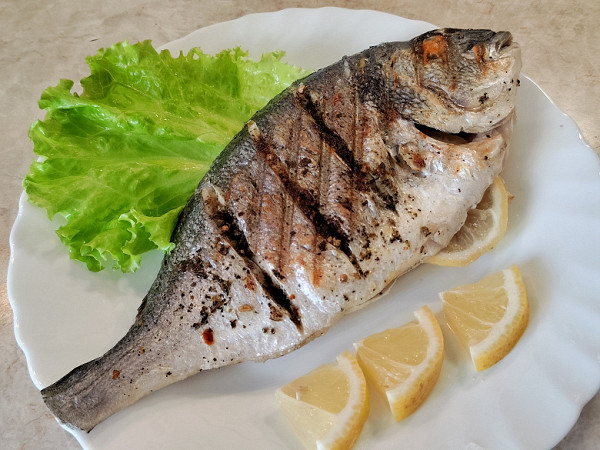
Result: excellent
Steak
Once you are familiar with the grill and its character, you can begin cooking the beef steak. For the experiment, we took two pieces of thin edge, one weighing 486 g, the second slightly smaller — almost 300 g.

The meat was removed from the refrigerator one hour before the start of the experiment to allow it to reach room temperature. Wash and dry with paper towels. No salt and pepper were added, just lightly greased with vegetable oil. The thickest piece was approximately 4.5 cm in height, the smaller one was slightly lower. Experience has shown that the grill lid evens them out to about 3.5-4 cm.
Preheat the grill to a maximum of 240 °C to “seal” the juices inside the steak. Fry for 3 minutes.

Then we lowered the temperature to 200 °C and left the meat to bake for another five minutes. When we opened the lid, we greatly regretted not using a thermometer, relying only on experience and many previous tests with the Polaris PGP 3005 grill. The meat turned out to be well done. The grill still cooked it quite well!

They cut it open and breathed a sigh of relief. The flesh is cooked to medium-medium well: a warm pink center, almost cooked through, with clear juices. It's still edible.
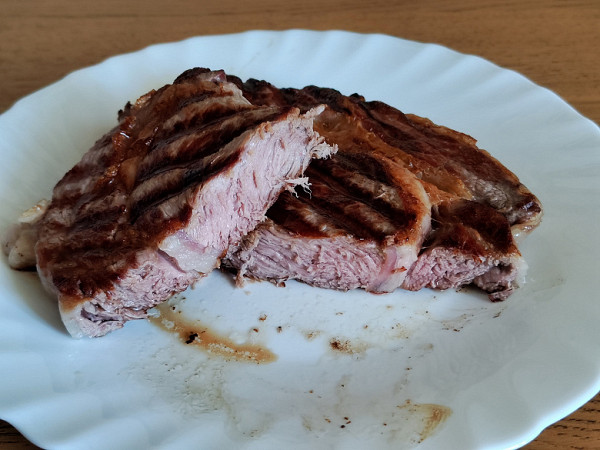
We were able to fairly accurately estimate the thickness of the piece and the required time for frying it. If the degree of roasting plays an important role, then in such cases it is better to trust the measuring instruments, and not just your eye.
However, we couldn't stop. We aimed to achieve a medium rare degree of roasting. We didn't have the same thick cut as in the previous test, so we purchased a name brand of beef from the store. The total weight of the two pieces was 390 g, their thickness varied from 1 to 2 cm. But given our conditions and tasks, the grill had to cope with them — cook without drying out the meat.

We decided to fry at 200°C, inserting a temperature probe into the thick part.

Two and a half minutes were enough for the meat to reach a temperature of 60 °C from the inside.
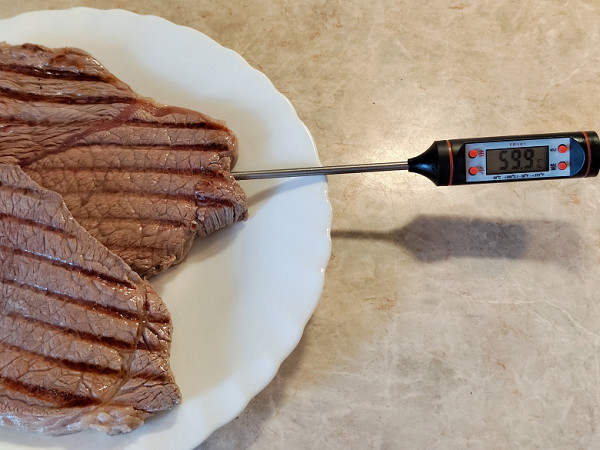
Well, we finally managed to get medium rare.
The steak was uneven in thickness, which resulted in almost all degrees of doneness from rare to medium well being presented in one part of the meat. This is more of a raw material quality issue than a grill issue. There are no problems with the operation of the device.
Result: excellent
conclusions
The Polaris PGP 3005 grill press coped well with all tests. We appreciated its simplicity and logic of control, sufficient power, variety of operating modes, as well as a high level of safety and elegant appearance. Despite some comments during the testing process, which related to certain aspects of the device’s operation, the overall impression of it remained positive.

I believe that the Polaris PGP 3005 grill is noteworthy for its removable panels with a built-in heating element and non-stick coating, which can be washed in the dishwasher, which greatly simplifies the process of caring for the device. The set also includes a mold in which you can bake dough products and bake various foods. The design of the grill is convenient, allowing you to unfold the panels 180° and form a single barbecue roaster. The top panel can be fixed at a certain distance from the bottom, which prevents squeezing of food.
However, we have comments regarding the accumulation of condensation on the front surface of the lid and the grease tray: when opening the lid, sometimes the draining liquid drips past, onto the table. There is also some imperfection in the uniformity of frying, although this does not significantly affect the quality and taste of the finished dishes.
Pros:
- ease of management and operation
- the ability to use the device as a pressure grill, fryer, mini-oven and oven
- heating element built into the panel
- removable panels that are dishwasher safe
- excellent test results
Minuses:
- condensation formation and flowing onto the table surface


